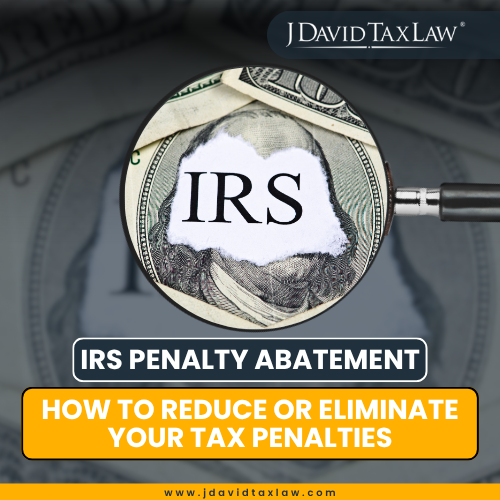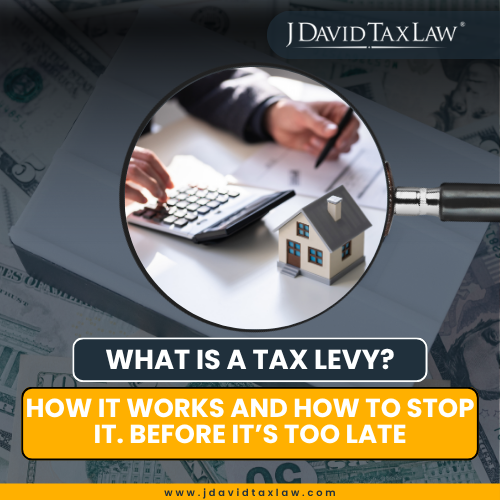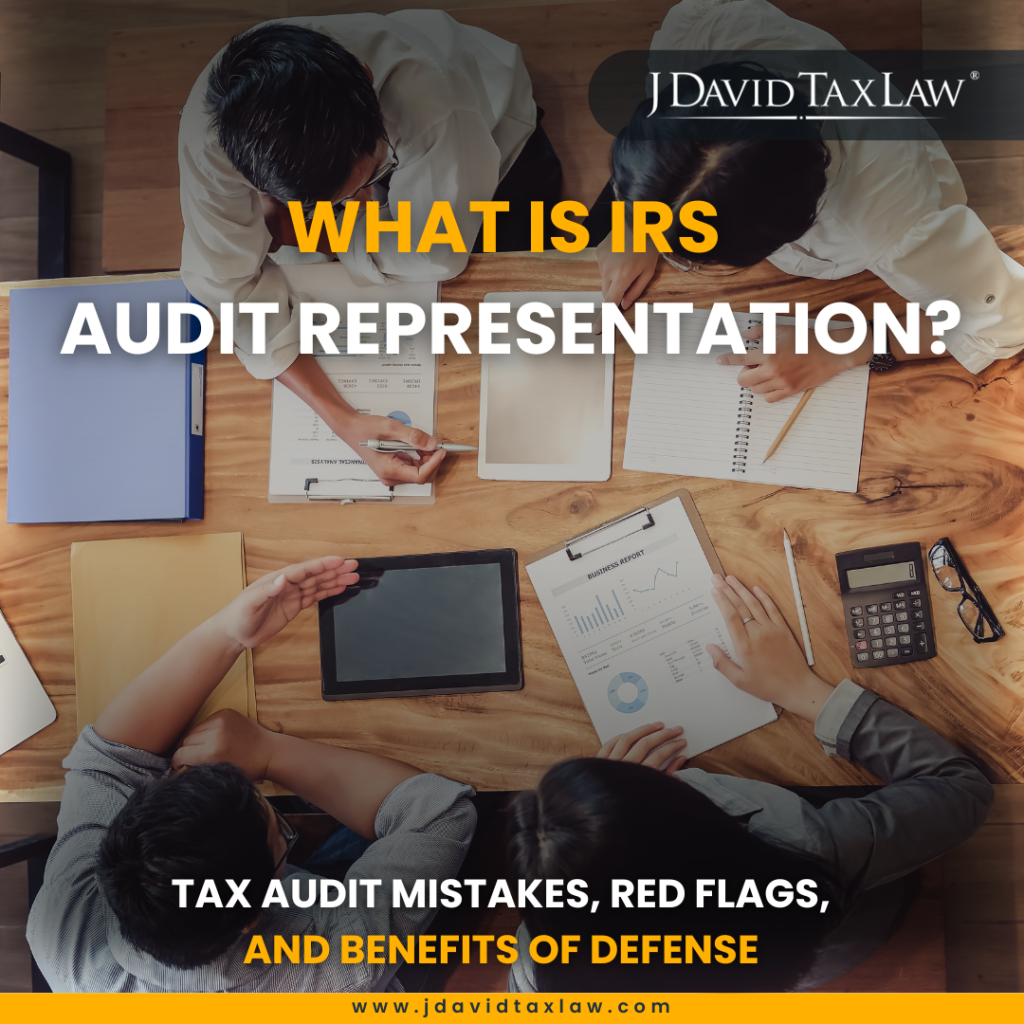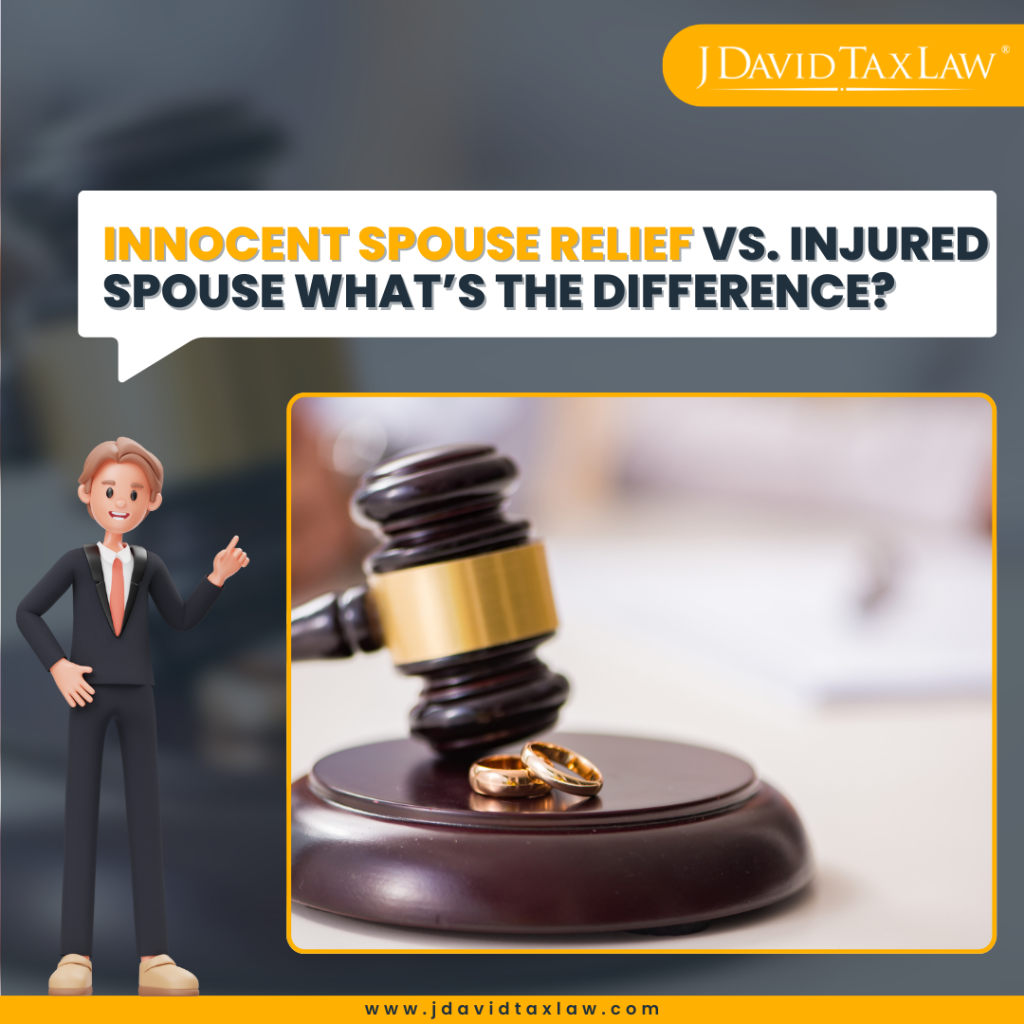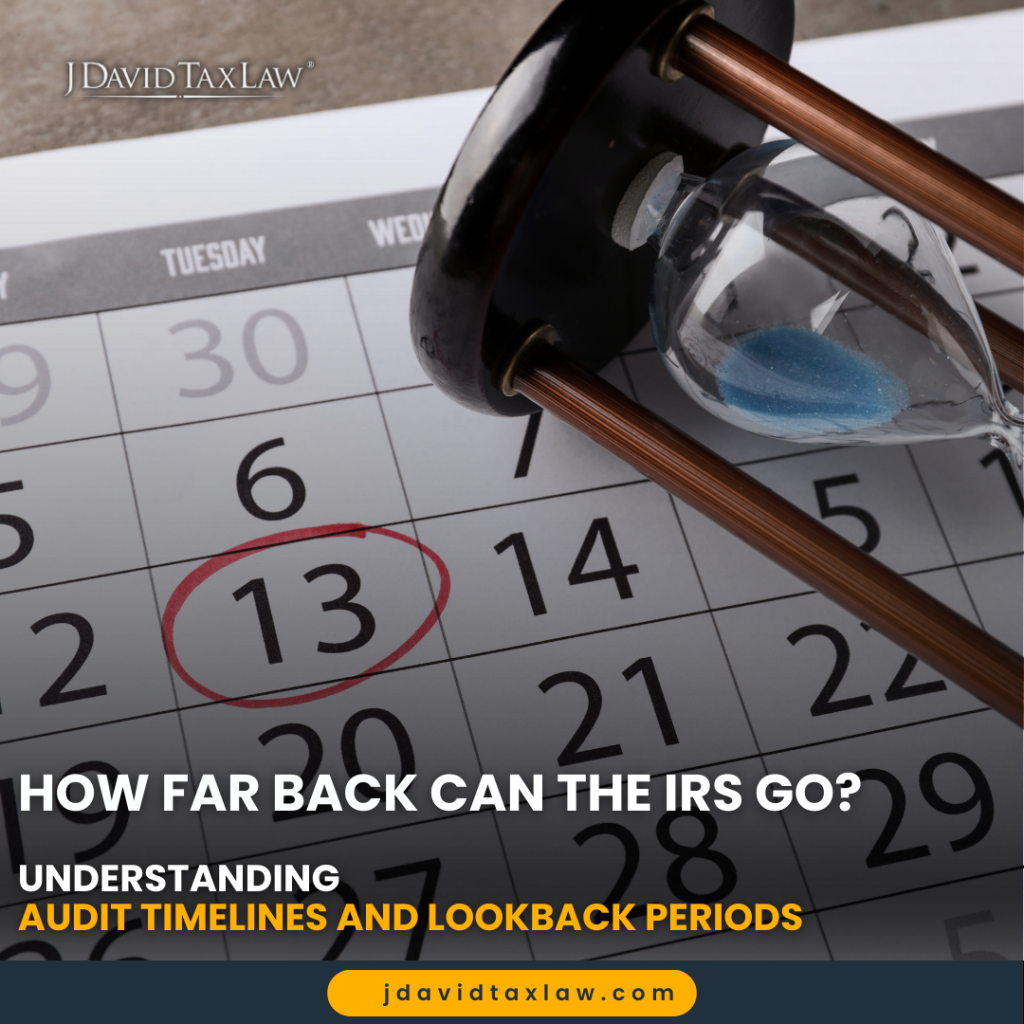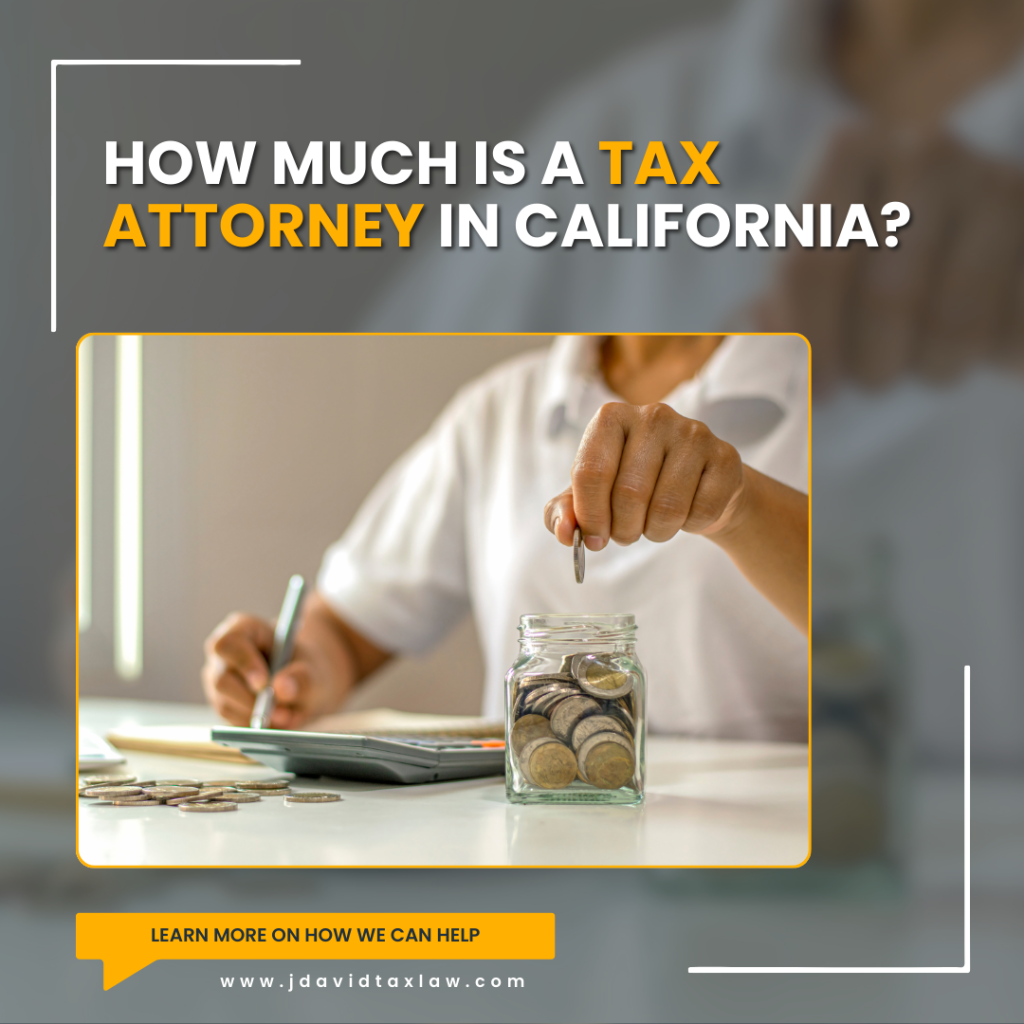The IRS imposes penalties when taxpayers fail to file returns on time, pay taxes by the deadline, or comply with certain tax rules. These penalties can add up quickly, sometimes reaching 25% or more of your total tax debt, and make it even harder to catch up once you’ve fallen behind.
Fortunately, the IRS offers several formal ways to reduce or eliminate these penalties through what’s known as penalty abatement. These programs are available to all taxpayers, but the rules, forms, and supporting documentation required can be complex. While the information is public, navigating the process without experience can be overwhelming or lead to unnecessary delays.
In this guide, we’ll walk through the most common and straightforward IRS penalty abatement options, how they work, and what you need to qualify. J. David Tax Law offers valuable guidance and support for taxpayers looking for appropriate options or who want help preparing a strong request via a professional.
5 Straightforward Ways to Reduce or Eliminate IRS Penalties
The IRS penalty relief process can be complex, but the core programs are publicly available and clearly defined. If you take the time to understand the rules—and provide the right documentation—you may qualify to reduce or completely remove penalties that have been added to your account.
Each of the following methods is a recognized IRS path to penalty abatement. While you can apply on your own, many taxpayers choose to work with a CPA or tax attorney to avoid delays, strengthen their case, or manage the paperwork.
1. First Time Penalty Abatement
First Time Penalty Abatement (FTA) is one of the most common ways to remove IRS penalties. It’s designed for taxpayers who’ve generally stayed compliant but made a one-time mistake, like missing a filing deadline or payment.
Who Qualifies
You may be eligible if:
You had no significant penalties in the past 3 years
All required tax returns are filed
You’ve paid or arranged to pay any tax owed
FTA applies to penalties for:
Late filing
Late payment
Failure to deposit payroll taxes
How to Request It
There’s no special form required, but most people use IRS Form 843 or call the IRS directly. In either case, you’ll need to:
Confirm your clean compliance history
Identify the year and type of penalty
Request “First Time Penalty Abatement”
Why Work With a Tax Attorney?
Getting FTA approved depends on meeting specific conditions. Firms like J. David Tax Law help clients build strong requests and avoid issues that delay or disqualify applications.
The IRS is Forgiving Millions Each Day. You Could Be Next.
2. Reasonable Cause Relief
If your failure to file or pay taxes was due to circumstances beyond your control, the IRS may remove penalties under Reasonable Cause Relief. This option is available when you can show that you exercised ordinary care but still couldn’t meet your tax obligations.
When It Applies
You may qualify if you missed deadlines because of:
A serious illness, injury, or death in the family
Natural disasters or fires
Inability to access records
Incorrect advice from a qualified tax professional
The IRS considers each case individually, based on the facts and your compliance history.
How to Request It
Submit a written request using IRS Form 843 (used to request abatement or refund of certain taxes and penalties). Include:
A clear explanation of what happened
Dates and relevant facts
Supporting documentation (medical records, disaster notices, etc.)
When to Get Help
If you’re unsure how to frame your explanation or what documentation is needed, a tax attorney can help prepare a well-supported request that meets IRS standards.
3. Statutory Exception
A Statutory Exception applies when the IRS imposes a penalty based on its own error, incorrect advice, or procedural mistake. This relief is available when you can show that you followed IRS instructions in good faith but were penalized for inaccurate or misleading guidance.
When It Applies
You may qualify for a statutory exception if:
You received written advice from the IRS that turned out to be incorrect
The IRS sent conflicting notices or failed to process your return properly
A penalty was caused by IRS administrative or system errors
You must provide proof that you relied on the IRS’s guidance or were directly affected by their error.
How to Request It
Use IRS Form 843 (request for refund or abatement) and include:
A copy of the incorrect IRS notice or written advice
A statement explaining how the error led to the penalty
Any additional documentation that supports your claim
4. Administrative Waivers
An Administrative Waiver is a form of penalty relief the IRS may grant under special circumstances, often tied to policy changes or systemwide issues. These waivers are initiated by the IRS and typically apply to a broad group of taxpayers without requiring individual hardship explanations.
When It Applies
Administrative waivers are generally available when:
The IRS announces relief due to systemic processing issues
There is a change in IRS policy or tax law that affects how penalties are applied
The IRS offers automatic relief for a specific period or event (e.g., post-COVID penalty forgiveness for 2019-2020)
How to Know If You Qualify
In many cases, you don’t need to apply—the IRS applies the waiver automatically. However, if you believe you qualify and relief wasn’t applied, you can request it using IRS Form 843, explaining the situation and referencing the relevant IRS notice or policy.
Note: These waivers are time-sensitive and based on IRS announcements. If you’re unsure whether you’re covered, a tax professional can help confirm your eligibility or file a formal request.
5. Disaster or Special Circumstance Relief
The IRS may provide penalty relief to individuals and businesses affected by federally declared disasters, public emergencies, or other large-scale events. This type of relief is offered under IRS disaster relief guidelines and applies automatically or upon request, depending on the situation.
When It Applies
You may qualify for disaster-related penalty relief if:
You live or operate in a federally declared disaster area
The IRS issues a notice delaying tax deadlines in your area
You experienced a hardship caused by events like hurricanes, wildfires, floods, or COVID-19
The IRS typically grants automatic extensions for filing and payment and may remove penalties for those who comply within the extended period.
How to Access It
Check the IRS Disaster Relief page to see if your area is listed.
If relief wasn’t applied automatically, you can request it using IRS Form 843, referencing the IRS notice covering your situation and including supporting documentation.
Note: Disaster relief is limited to specific timeframes and geographic areas, and not all penalties qualify. A tax professional can help determine if your situation is covered and assist with filing.
When to Work With a Tax Attorney
While penalty abatement programs are available to the public, applying for them correctly requires a clear understanding of IRS procedures. If you’re unsure which type of relief fits your situation, or if the penalties involve multiple years or large balances, working with a tax professional is a smart decision.
Tax attorneys can review your IRS records, determine which relief applies, and prepare a well-documented request that aligns with IRS standards. They can also help avoid errors, like missing eligibility requirements or submitting incomplete forms, that often lead to delays or denials.
For legal strategies such as First Time Abatement or Reasonable Cause Relief, a tax attorney, like J.David Tax Law, can offer decades of experience in tax penalty relief to help you make a compelling case.
Conclusion
IRS penalties can add up quickly, but they aren’t always permanent. Whether you made a one-time mistake, faced unexpected hardship, or were affected by an IRS error, several legitimate options exist to help reduce or eliminate the penalties applied to your tax account.
From First Time Penalty Abatement to Reasonable Cause Relief, the IRS has formal processes in place to provide taxpayers with a fair opportunity to get back on track. While these programs are publicly available, applying them effectively—and avoiding mistakes that could lead to denial—often requires professional insight.
If you’re unsure where to start or want help building a strong request, J. David Tax Law can guide you through the process. Contact us today for a free consultation on your IRS penalty abatement needs.
Frequently Asked Questions About IRS Penalty Abatement
IRS penalty abatement is a process that allows eligible taxpayers to have certain penalties reduced or removed. These penalties typically stem from filing late, paying late, or failing to deposit payroll taxes. The IRS provides relief through programs like First Time Penalty Abatement, Reasonable Cause Relief, and Statutory Exceptions. J. David Tax Law helps taxpayers determine the best IRS tax relief option for their situation and prepares the necessary documentation to support their request.
Yes, the IRS offers a First Time Penalty Abatement program that allows taxpayers to remove penalties for late filing or payment if they have a clean compliance history. To qualify, you must have no significant penalties in the previous three years, all required tax returns filed, and taxes paid or under an installment agreement. It’s often one of the simplest ways to reduce penalties for a one-time mistake. J. David Tax Law regularly helps clients qualify and apply for first time penalty abatement, ensuring no steps are missed.





